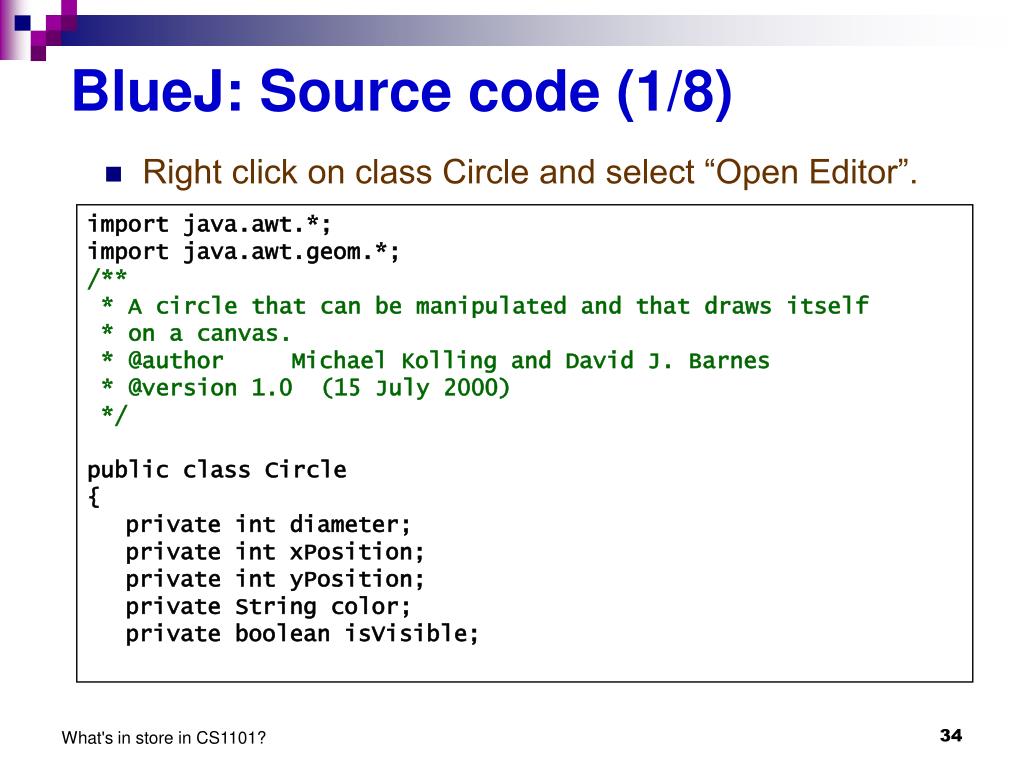

Once an object has been created, a menu offers all the object’s public methods, and any of them can be interactively invoked by selecting it from this menu (see Figure 3). The diagram’s arrows display inheritance and uses relationships-which is when a class references another.īlueJ is an excellent environment in which to gain a good understanding of fundamental principles of object-oriented programming. When opening BlueJ, the first thing shown to a user is a diagram of the classes in the project and their relationships. The first, most obvious-and most fundamental-aspect of BlueJ’s functionality that is relevant here is its presentation of classes and objects. We will now discuss BlueJ’s interaction features in more depth-the first few here, and the rest in Part 2. However, they presented only a partial insight into BlueJ’s toolset. The Killer Features: Interaction and VisualizationĪ previous issue of Java Magazine introduced BlueJ’s features by presenting a small programming example, and another issue discussed testing in BlueJ in more detail.īoth of these articles touched on BlueJ’s interactive features and made use of some of them. These are the important tools for learning to program and forming your mental models, and, therefore, they will be the focus of the rest of this article. It is not merely about offering fewer tools, but about offering different ones.īlueJ has various bits of functionality not found in many other environments, and most important among them is a greater level of interactivity and visualization. BlueJ’s toolset is not a subset of one of the bigger systems.
#Bluej source code professional
One of the leading design goals of BlueJ is well expressed in a famous quote by Antoine de Saint Exupéry:īut when there is nothing left to take away.”īut it is also important to note that this does not mean that an educational environment is simply a cut-down version of a professional one. In fact, one of the greatest achievements of BlueJ is to present a complex problem domain-programming-in a simple fashion.

This should not be mistaken as simplicity of functionality: BlueJ offers some sophisticated tools that help learners along the way, and we will discuss some of them shortly. These are the important tools for learning to program and forming your mental models.īlueJ’s interface (see Figure 1) appears very simple and unthreatening.
#Bluej source code code
Students look at lines of Java code and struggle to understand the difference between classes and objects.īlueJ has various bits of functionality not found in many other environments most important among them is a greater level of interactivity and visualization. Objects, for example, hardly exist as a tangible abstraction in a typical interface. These are not well represented in professional environments. Yet, what is really much harder, and much more important, to learn are the fundamental abstractions: classes, objects, and interactions. Beginners using these systems stare at lines of code, so it is not surprising that what they think about is lines of code. The main focus in these environments is on source code. They provide a great toolset for programmers who know what they are doing, but they do little to help learners develop the mental models they need to become good programmers. Environments for Experts, Environments for LearnersĮnvironments designed for professionals-NetBeans, Eclipse, and the like-work very well for experts. Beginners need to develop this mental model, and an educational programming environment must help learners do so. All of us who have been around programming for a while know that syntax is neither the interesting nor the hard part.Īnd this is the crucial difference between beginners and experts: experts have a well-developed mental model of the fundamental principles of object orientation, while beginners do not.


 0 kommentar(er)
0 kommentar(er)
